About
Number Verifier represents an application that allows to set up settings based on which the numbers verification process is executed.
While the standard number verification in Trados Studio may often be sufficient there are some occasions when a bit more control would be preferable, for example when translating documents that contain lots of numbers. This Number Verifier plug-in allows you to fine-tune settings to provide you with the desired balance between the number of false positives and potentially missed errors.
How to use
- Install application
- Open project
- Go to Project Settings -> Verification -> Number Verifier
- Select all the needed settings
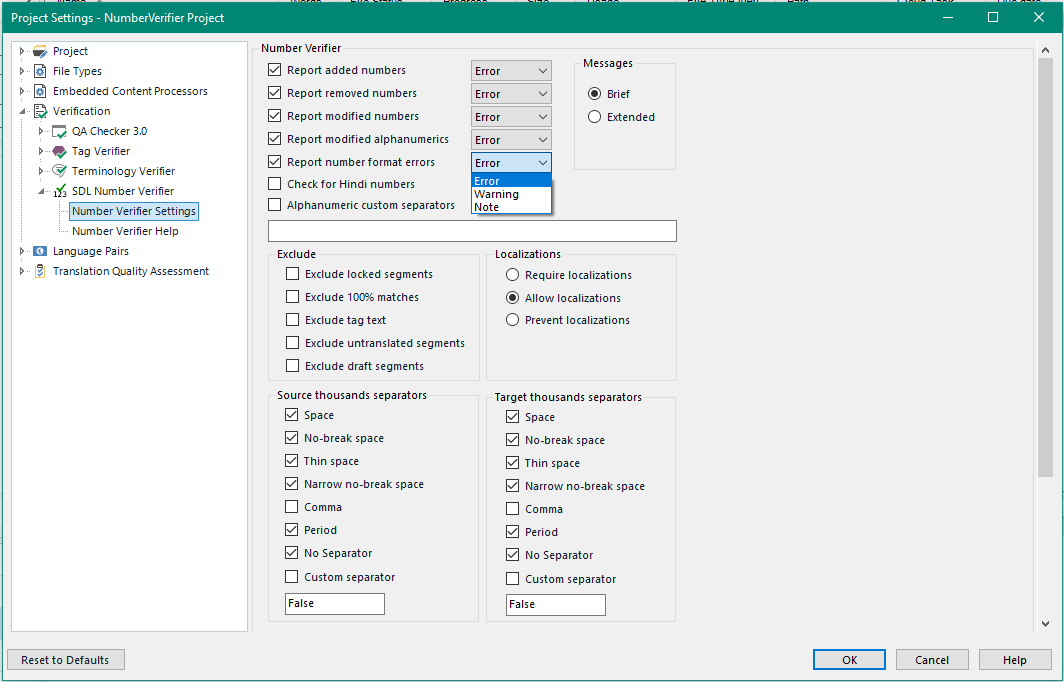
- Press Ok.
To have the app running, ensure that under the 'Verification' option the 'Number Verifier' is checked.
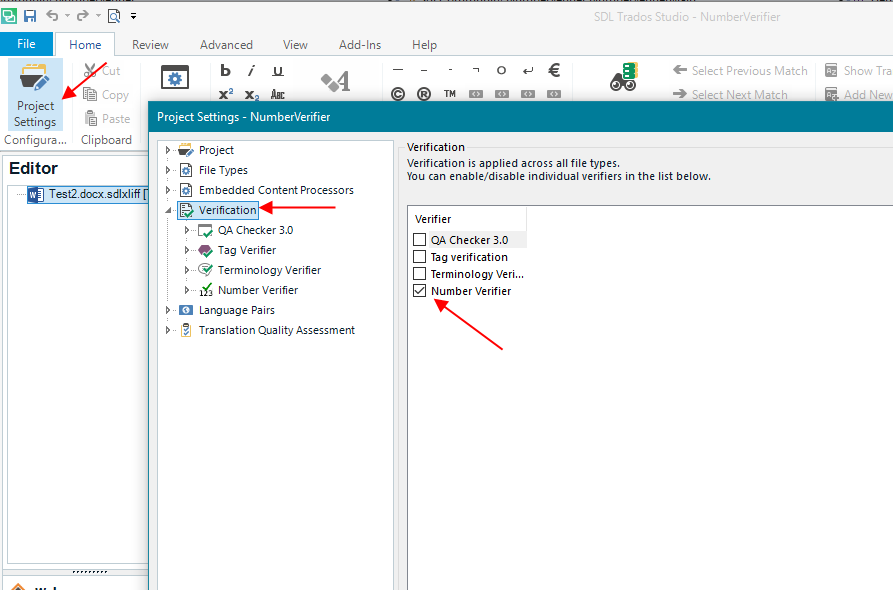
Using the Number Verifier plug-in is simple: the first four options always need to have at least one of them checked:
- Report added numbers
- Report removed numbers
- Report modified numbers
- Report modified alphanumeric numbers
- Report number format errors
All other settings apply to one or more of these options. Once you are clear about what type of error you wish to check for you can set which segments should be checked. The options are basic and allow you to exclude segments that are locked or 100% matches, as well as segments that have no translation at all. An important point to note is that segments with content, but with the status ”untranslated”, will not be checked if you use the ”Exclude untranslated segments” option. It is assumed that segments with content will be draft at least.
You can select "Exclude tag text" if you find that you get duplicate error messages since the change of a number in a tag constitutes a tag change that is reported by the tag verifier.
There have also been cases where leading zeroes have caused problems in verifying numbers. To cater for this you will find an option at the bottom of the settings to ”Omit leading zero” from the source and/or target.
The Number Verifier also creates a log file of the issues it has found. You can select the Extended option for Messages if you want the source and target text to be included in the log file. A nice enhancement in version 1.1.8.6 and above is to identify the numbers that are affected in the extended option. This is very useful if you have many numbers in the segment and only one or two are wrong.
Alphanumerics
In addition to plain numbers, the Number Verifier plug-in can also be used to find changes to alphanumeric names. For example, if VT500 has accidentally been translated as VR500 an error can be displayed. Here, an alphanumeric name is defined as a string of characters starting with one or more uppercase letters (A-Z) followed by any combination of digits (0-9) and uppercase letters. (Please note that if VT500 has been translated as VT300 this will also be identified as a modified number.)
You’ll also find an option to specify custom Alphanumeric separators. Studio will recognise alphanumerics but only under certain conditions:
- must not start or end with underscores, hyphens or full stops
- must not contain both dashes and full stops
- must contain at least one number and one letter
- must not contain lowercase characters and dashes
The Number Verifier allows you to specify whatever separators you wish and still verify correct transposition from the source to the target translation.
Localizations
Studio always uses the rules set by the Windows operating system to decide what a number should look like. In reality, life is more complex than that, so there are three options you can use and you must select one of them.
- Require localizations
If a number in the source is identified as using one of the possible thousands or decimal separators specified for the source separators, the translation must contain corresponding numbers with any of the separators specified for target separators or else the number will be considered modified/unlocalized.
- Allow localizations
If a number in the source is identified as using one of the possible thousands or decimal separators specified for the source separators, the translation may contain corresponding numbers with either the same separator as the source number or with any of the separators specified for target separators, or else the number will be considered modified/unlocalized.
- Prevent localizations
The same thousands or decimal separators as in source must be retained in the translation or else the number will be considered modified.
- Thousands and decimal separators
You can select the thousands and decimal separators you want to allow. For example, you may allow one or more thousands separators depending on language standards. Similarly, you may allow for both a period and a comma to be used as a decimal separator, in order to allow for cases where for some reason more than one language standard should be allowed. The selected separators will then be combined with the Localizations setting to determine what should be considered a modified/unlocalized number. You can also specify a custom separator to suit any requirement you may be dealing with.
- Hindi Numbers
The option ”Check for Hindi numbers” should be disabled unless you specifically wish to QA check the use of Hindi as opposed to Arabic numerals. The rules used are:
Arabic -> Hindi
0 -> ٠
1 -> ١
2 -> ٢
3 -> ٣
4 -> ٤
5 -> ٥
6 -> ٦
7 -> ٧
8 -> ٨
9 -> ٩
10 -> ١٠
The numbers are written left to right as they are for Arabic numerals but without any thousand separators. The decimal becomes a comma. So this:
1,234.89 or this 1.234,89
would be written like this:
١٢٣٤,٨٩
Number Format Errors
How to run verification
After all the settings were applied, the user can start translating the document. After confirming the segment(s), by pressing the F8 keyboard, the Number Verification process is executed. Once is finished, if any warning/errors were found, are all displayed in the Studio Messages window.
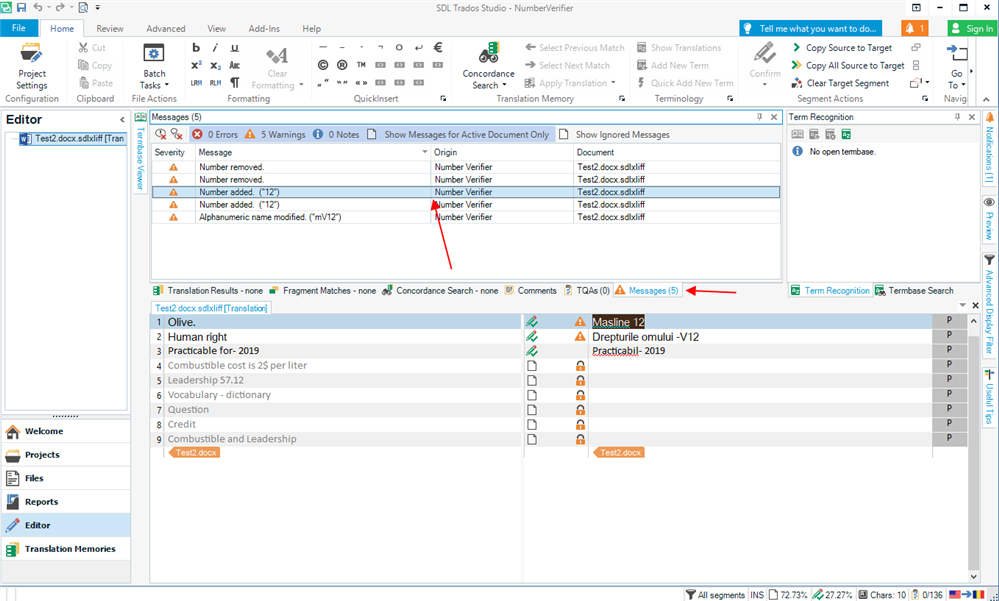
Show message details
Users can visualize the message details using 2 options, that can be selected from the Number Verifier Settings grid:
- Brief
- Extended
The "Brief" option shows the details which include the document name, error message with the text issue(s), the segment number where the issues were found and also the content of the Source and Target. (The description of the "Brief" option can be seen also if the user hovers the mouse over it.)

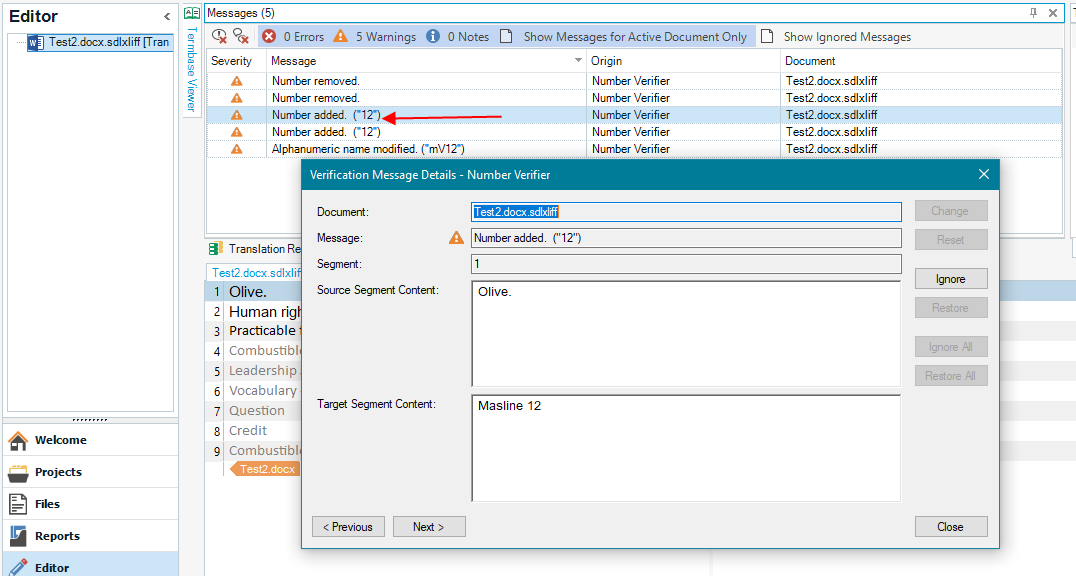
The "Extended" option displays the exact text which was found as an issue in the translation. The found text is coloured, so it can be easily distinguished. (The description of the "Extended" option can be seen also if the user hovers the mouse over it.)

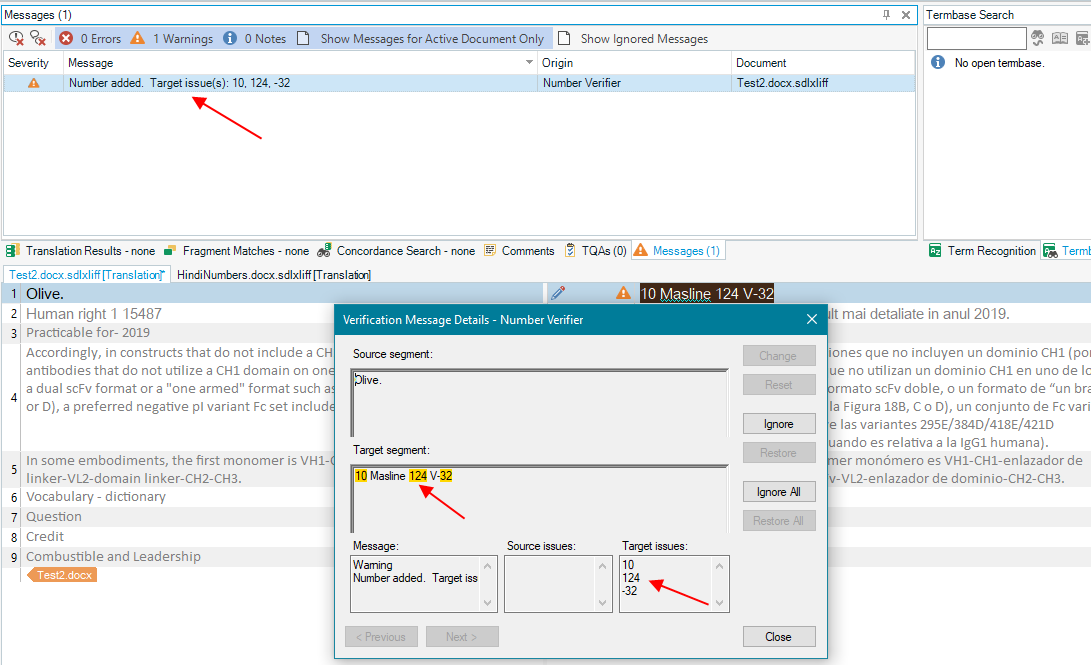
Tooltips
1. Tooltips added for the Messages options in "Number Verifier Settings" grid
Users can see the details of the options "Brief" and "Extended" by hovering the mouse over each option.


Extended Results
The "Extended" option is showing the verification results in more detail.
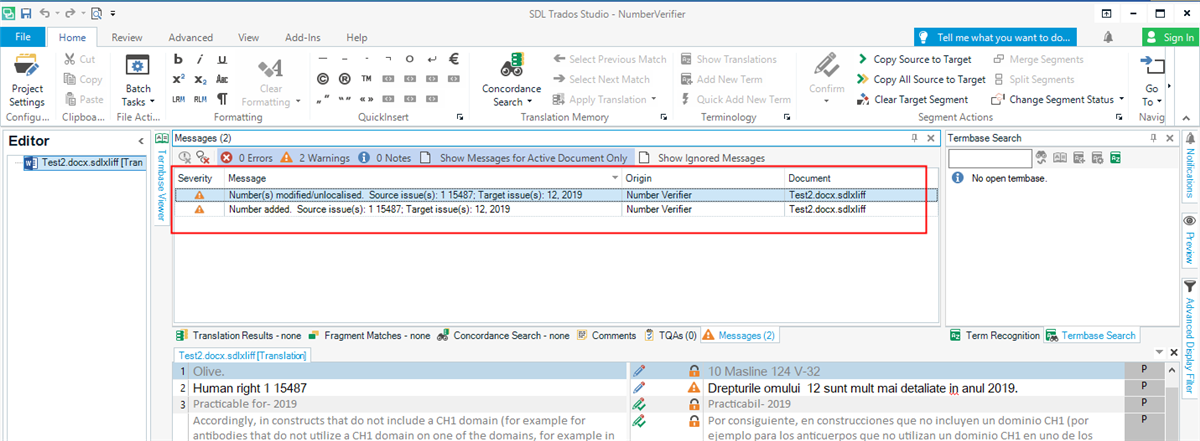
Logging
The application logs information about the flow which is useful to identify issues that might occur. If some errors are caught, the NumberVerifierLogs.txt file will be created at the following location: C:\Users\{UserName}\AppData\Roaming\SDL Community\Number Verifier\NumberVerifierLogs.txt and it will contain errors details. The file can be attached to the email / Sdl Community forum topic when a problem regarding the application is raised.
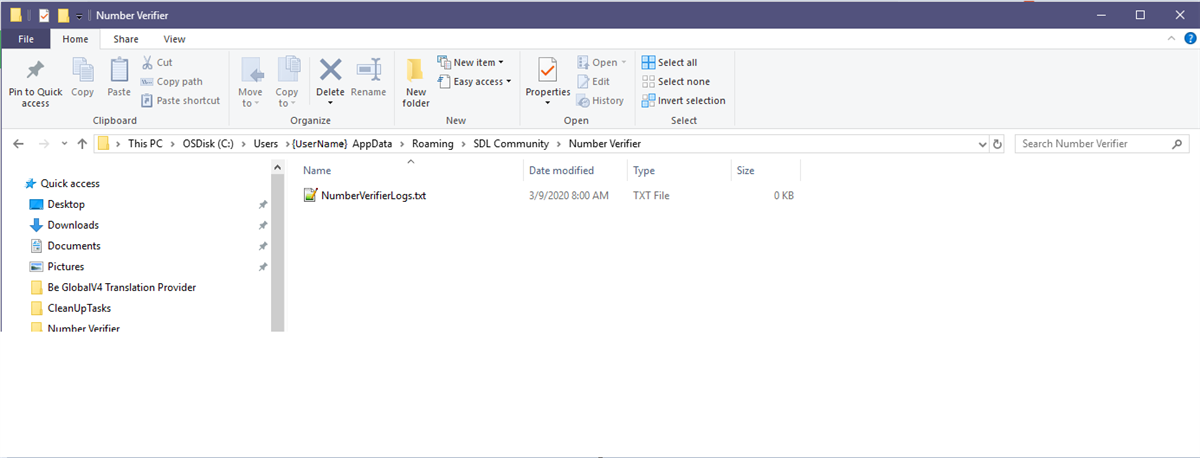
Consistency Checker
This checks to see whether numbers (or sequences, if at least one of them is not a number) from the source match those in the target.
Given the fact that the user makes some choices regarding the separators used as thousand and decimal separators for the source and the target separately, and also whether 0 can be omitted either in source or in target, to be able to decide whether the number in the source is the same as the number in the target, we have to:
- Establish whether we're dealing with numbers or just sequences of digits and other symbols
- See if the number in the source has the same value as the one in the target or whether they can be interpreted as such if they're ambiguous (considering settings)
From the perspective of the user, the errors are of two kinds:
- Number-level errors (resulted from phase 1, above)
- Segment-pair-level errors (resulted from phase 2, above)
In the normalized form of the number:
t - thousand separator
d - decimal separator
1. Number-level errors
|
Error
|
Description
|
|---|---|
|
Error
|
Description
|
|
Separator after decimal |
There cannot be a separator after the decimal in a number |
| The number cannot have two different thousand separators | The number cannot have two types of thousand separators in the same number |
| Too many decimal separators | The number cannot have more than one decimal separator |
| Separator not valid | This separator isn't present in the separators list for the localization |
| Decimal separator not valid | This separator isn't present in the decimal separators list for the localization |
| Thousand separator not valid | This separator isn't present in the thousand separators list for the localization |
| The number cannot have the same character as thousand and as a decimal separator | The same character cannot be both thousand and decimal separator in the same number |
2. Segment-pair-level errors
|
Error
|
Description
|
|---|---|
| Number added | The number is absent in the source while present in the target |
| Number removed | The number is present in the source while absent in the target |
| Different sequences | The sequences of digits and separators are different (at least one of them is not a number) |
| Different values | The numbers are different both in sequence and in value (but they are numbers) |
| Same sequences but different values | The numbers have the same sequence but the separators have different roles |
| Target unlocalised | The source is a number while the target isn't but they have the same sequence of digits and separators, suggesting that the user forgot to use the correct target separators |
| Source unlocalised | The target is a number while the source isn't but they have the same sequence of digits and separators, suggesting that the user forgot to add the correct source separators in the settings |
Also, there's a new setting added:
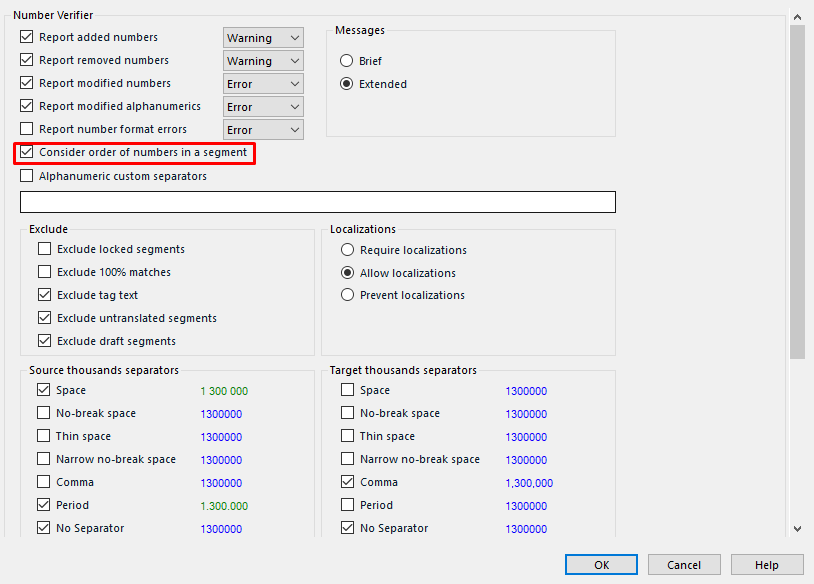
When
- Checked → numbers will be tested in the order they're placed in the segment pair
- Unchecked → order will not be taken into consideration

 Translate
Translate
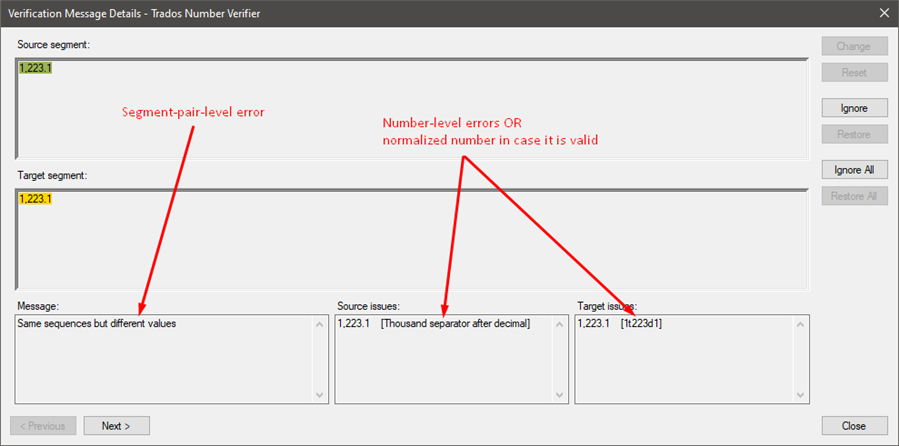
Choose to report number format errors when you want to recognize both generic and custom issues given specific settings provided by the user.